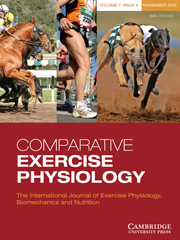Article contents
Effect of water temperature on heart rate of horses during water treadmill exercise
Published online by Cambridge University Press: 01 November 2008
Abstract
While there have been several studies of heart rates (HRs) of horses during exercise in water, the effect of exercise in water of different temperatures has not been reported. While the increase in HR during exercise is primarily related to the intensity of exercise and therefore metabolic rate, increasing body temperature can also contribute to elevations in HR separate to muscle metabolic activity per se. When exercising in water, as the thermal conductivity is greater than that of air, the temperature of the water can have a marked influence on body temperature and heat exchange compared with exercise in air. The aim of the present study was to investigate the effect of water temperature on HR of horses walking for 16 min on a water treadmill in water up to the height of the scapulohumeral joint. Eight horses were studied in three separate exercise tests in water at 13, 16 and 19°C in a randomised order in an ambient temperature between 4 and 10°C. HR was recorded continuously throughout exercise. Mean HR over the 16 min exercise period was the lowest in 13°C water (79 ± 6 bpm), intermediate in 16°C water (89 ± 7 bpm) and the highest in 19°C water (92 ± 5 bpm). A one-way ANOVA and post hoc least significant difference test comparing mean HRs at each temperature showed that there was a significant difference between HRs in water at 13 and 16°C (P < 0.0001) and in water at 13 and 19°C (P < 0.0001), but not between water at 16 and 19°C (P>0.05). Individual HRs for horses during the first minute of exercise in water of 13°C were significantly different from those in water at 16°C (P < 0.0001) and 19°C (P < 0.0001). The gradients of the log HR–time relationships showed a significant difference between exercise in the latter part of exercise in 19°C when compared with 13°C (t = 34.0, P < 0.05) and 16°C (t = 67.4, P < 0.05), suggesting that cardiovascular drift is likely when exercising in temperatures of 19°C and above. In conclusion, to the best of our knowledge, this is the first study to describe the effect of water temperature in the range of 13–19°C on the HR of horses during water treadmill exercise. Further studies to investigate the effect of different water depth and temperature combinations are indicated.
Information
- Type
- Research Paper
- Information
- Copyright
- Copyright © Cambridge University Press 2009
References
- 10
- Cited by

